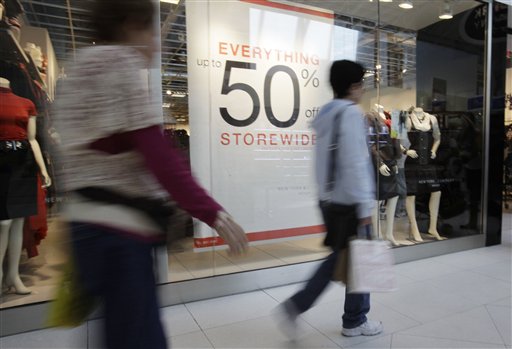
At the start of the critical holiday shopping season, the economy received a dose of mixed news Wednesday.
Consumers barely increased their spending in October, and businesses pulled back on investment in long-lasting manufactured goods. Still, Americans’ pay rose by the most in seven months, a sign they may spend more in coming weeks.
Some economists were discouraged by the reports, especially after a separate report earlier this month showed Americans spent more on retail goods in October for the fifth straight month.
Paul Dales, a senior U.S. economist with Capital Economics, said the slower consumer spending growth and decline in business investment suggest economic growth in the October-December quarter could be weaker than first thought. He now expects just 2.5 percent growth instead of 3 percent.
Consumer spending increased 0.1 percent last month, the Commerce Department said. It was the poorest gain in four months. Spending on durable goods such as autos showed a solid increase. But spending on nondurable goods, such as food and clothing, fell.
“Today’s report was a good reminder that much of what consumers spend their money is not purchased at the shopping mall, but is rather spent on their homes and on their health,” said James Marple, senior economist at TD Economics. “With services spending making up 65 percent of total consumption expenditures, the poor performance here more than made up for the continued gains in spending on goods.”
The report also showed that Americans earned more in October. Income increased 0.4 percent last month, the best showing since March. Private wages and salaries drove the gain.
The solid increase followed five straight months of weak income gains. And when subtracting taxes and adjusting for inflation, income rose 0.3 percent in October.
Many Americans chose to save the extra money. The savings rate ticked up to 3.5 percent of after-tax incomes, up from 3.3 percent in September — the lowest level since December 2007, the month the recession started.
Some economists predicted consumer spending would slow because Americans spent more over the summer while earning less. Consumer spending is important because it makes up 70 percent of economic activity.
A separate Commerce report showed businesses cut orders for durable goods in October. The 0.7 percent decline was largely because of a big drop in volatile commercial aircraft orders.
Still, demand for core capital goods, which are considered a good proxy for business investment spending, dropped by the most since January. That followed two straight months of gains.
Durable goods are products expected to last at least three years. Orders fluctuate sharply from month to month.
A third report showed the number of Americans seeking unemployment benefits rose slightly last week to a seasonally adjusted 393,000 after two months of steady declines.
The four-week average of applications, which smooths week-to-week fluctuations, fell to its lowest level since April, the Labor Department said. The downward trend suggests companies are laying off fewer workers.
The economy grew at a rate of 2 percent in the July-September quarter. The modest growth is not nearly enough to lower the unemployment rate, which has been stuck near 9 percent for more than two years.
Many Americans could take home less next year if Congress doesn’t extend a Social Security tax cut and emergency unemployment benefits. Both expire at the end of this year.
The Social Security tax cut gave most Americans an extra $1,000 to $2,000 this year. If long-term unemployment benefits expire, roughly 6 million families could lose an average of $300 per week. For some, that’s their only source of income.
Both changes would leave Americans with an estimated $165 billion less to spend. The Federal Reserve expects the economy to grow only 2.7 percent next year, and economists say the expiration of the two programs could reduce growth by a full percentage point.
Copyright 2011 The Associated Press.


























